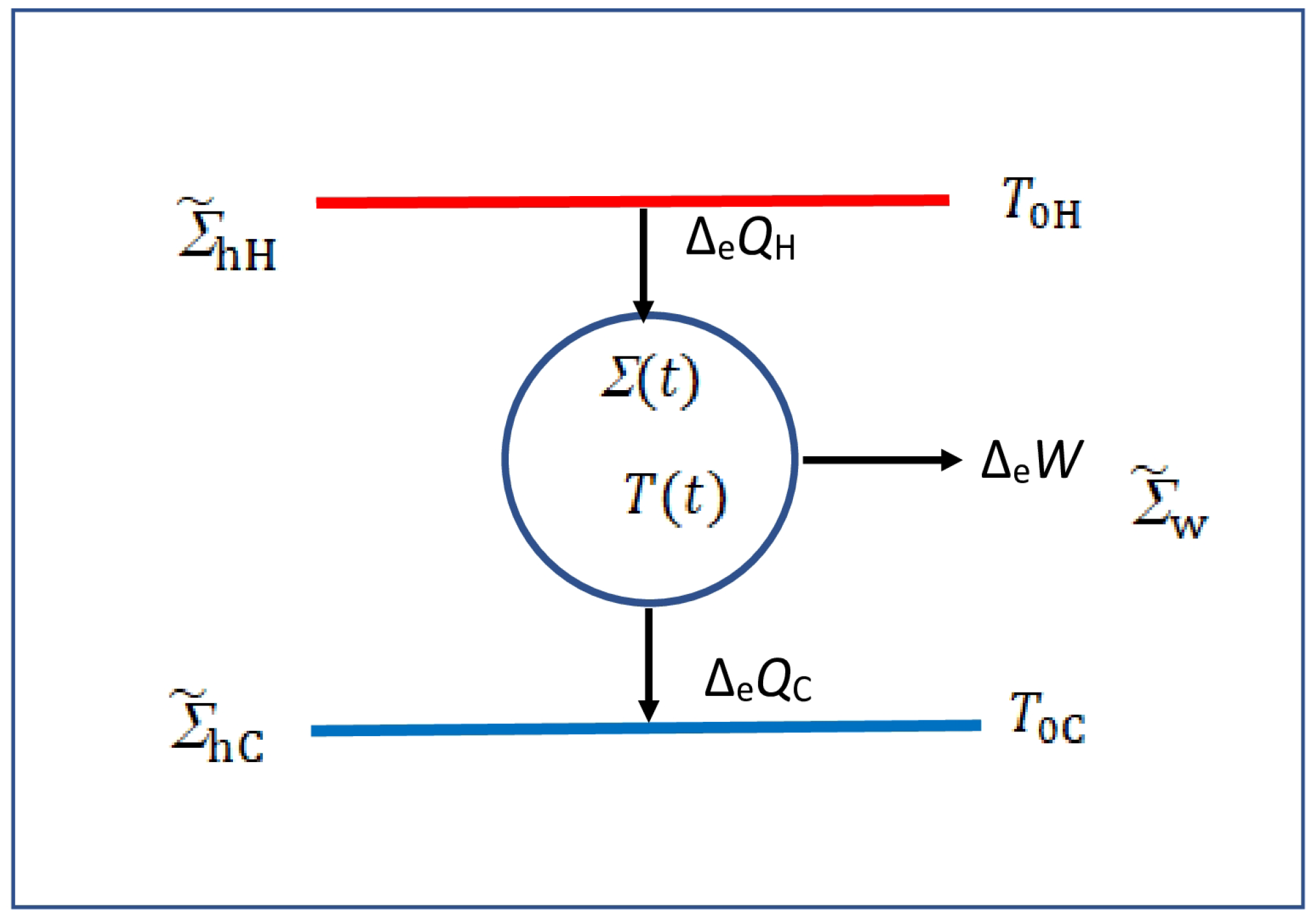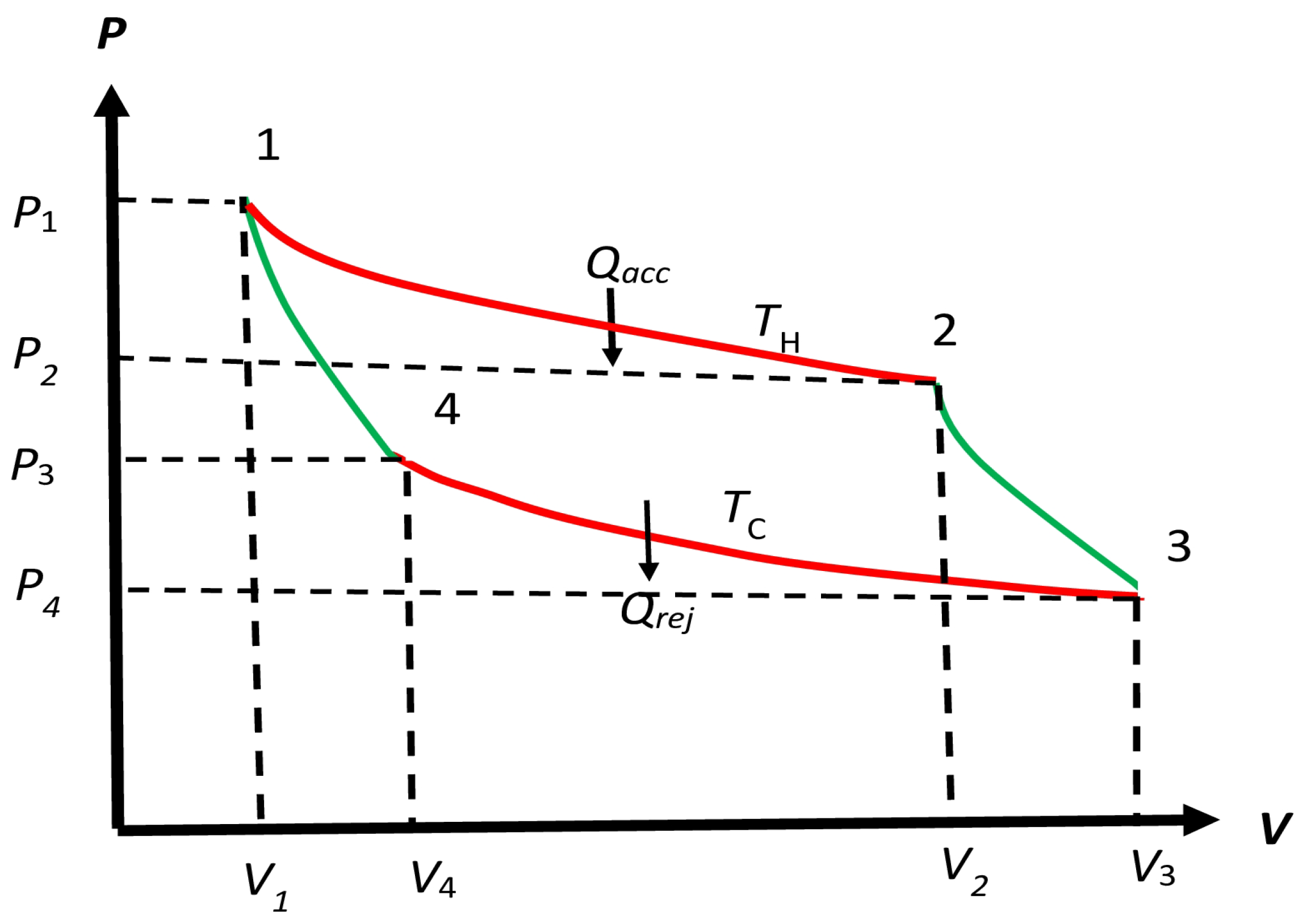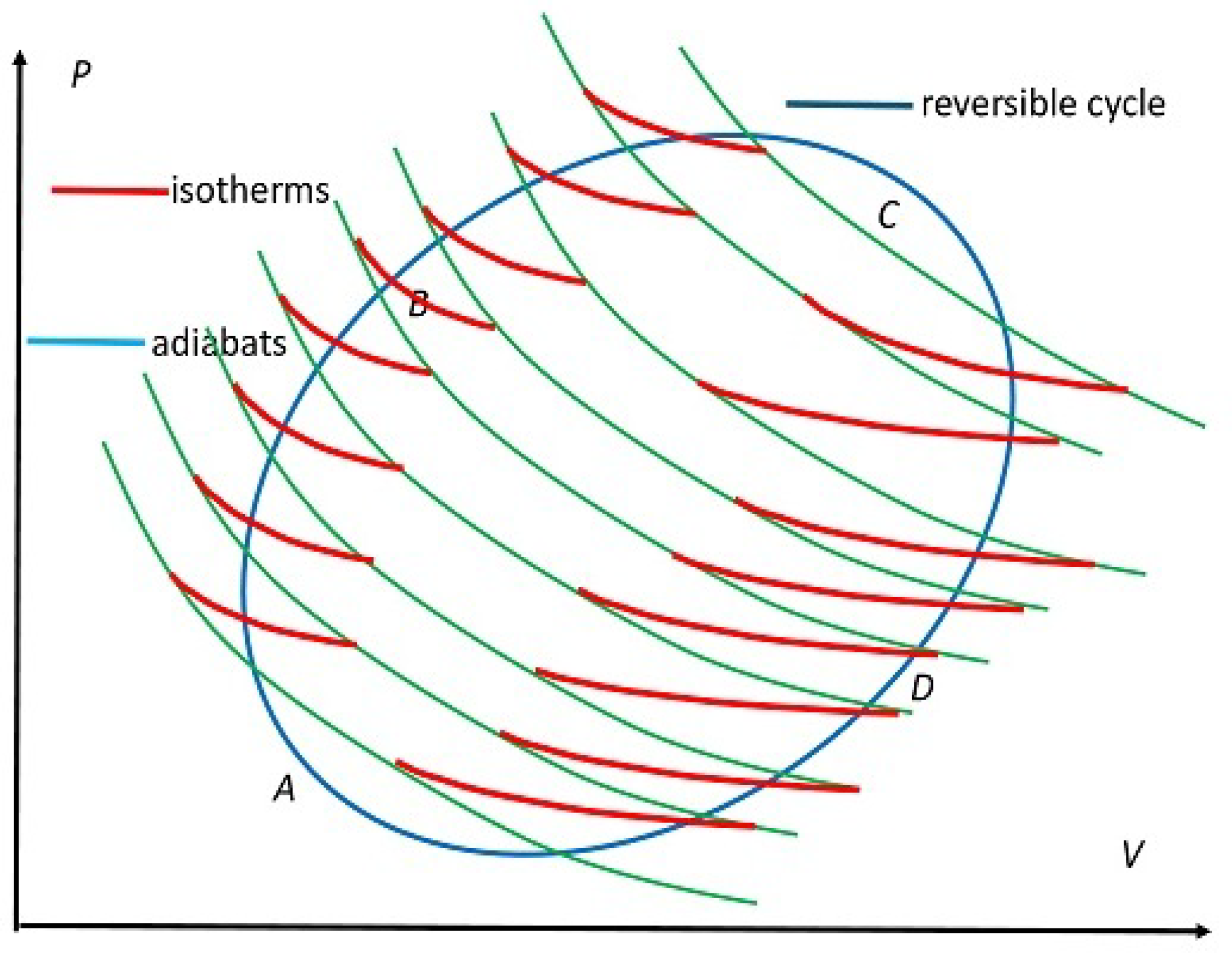Carnot Theorem Revisited: A Critical Perspective
Abstract
1. Introduction
1.1. Some Historical Notes
Reflections-1: “Heat is simply motive power, or rather motion which has changed its form. It is a movement among the particles of bodies. Wherever there is destruction of motive power, there is at the same time production of heat in quantity exactly proportional to the quantity of motive power destroyed. Reciprocally, wherever there is destruction of heat, there is production of motive power.”
Carnot Theorem (C-Th)
- C-Th-1: Wherever there exists a difference of temperature, motive power can be produced [1] (p. 51).
- C-Th-2: The maximum of motive power resulting from the employment of steam is also the maximum of motive power realizable by any means whatever [1] (p. 55).
- C-Th-3: The motive power of heat is independent of the agents employed to realize it; its quantity is fixed solely by the temperature of the bodies between which is effected, finally, the transfer of the caloric [1] (p. 68).
- Q1.
- Does by “any means whatever” mean any operational procedure, i.e., protocol different from those of the Carnot cycle but resulting in a reversible engine?
- Q2.
- Does independent of the agents have anything to do with the interplay between the working substance (WS) and the protocol of the cycle?
- Q3.
- Does “between which is effected” allow for a collection of mediums with temperatures lying between a chosen hot and cold temperatures and in Figure 1 but still result in a reversible engine?
1.2. Motivation
I propose to identify this thermodynamic entropy by the Carnot–Clausius entropy to give him the full credit that he deserves.
“… the efficiency of the Stirling cycle with a reversible regenerator became a source of confusion, and someone tried to remove the confusion with a careless definition of heat input. Together these two mutually supportive ideas spread like a virus throughout many articles and textbooks on thermodynamics. They spread because they sell an attractive idea: if all reversible engines are alike, then Nature is simple and parsimonious….”
Reflections-2: “… all change of temperature which is not due to a change of volume of the bodies can be only a useless reestablishment of equilibrium in the caloric. The necessary condition of the maximum (macrowork) is, then, that in the bodies employed to realize the motive power of heat there should not occur any change in temperature which may not be due to a change in volume. Reciprocally, every time that this condition is fulfilled the maximum will be attained. This principle should never be lost sight of in the construction of heat engines; it is its fundamental basis. If it cannot be strictly observed, it should at least be departed from as little as possible.”
- 1.
- C-Th-2 applies to any arbitrary reversible engine and its irreversible counterpart but with a prescribed protocol specifying the set of processes (operations) and the working substance.
- 2.
- C-Th-2 applies to reversible Carnot engine and irreversible Carnot engine for the non-fixed (B) protocols of and and prescribed working substance.
- 3.
- C-Th-3 applies to all reversible engines and not just , provided they are formed under Fix-Protocols, but not to any other reversible engines formed under NonFix-Protocols.
1.3. Layout
2. Preliminaries
2.1. Temperature in Carnot’s Reflections [1]
2.2. Reversible Carnot Cycle (RC Cycle)
- C-Th-2M: All heat engines operating between the same two heat mediums cannot have efficiencies greater than a reversible Carnot engine operating between the same mediums.
- C-Th-3M: Every reversible heat engine operating between the same two heat mediums is equally efficient, regardless of WS employed or the operation details, and is equal to that of the Carnot engine , which depends solely on the temperatures of its hot and cold heat mediums.
2.3. Full Specification of Carnot Cycle
2.4. Cycle Protocols and Working Substance
- A.
- Fix-Protocol: These protocols are externally forced from the heat and work mediums that then determine the shape of the cycle. As a result, WS responds to the protocol in this case by adjusting its macrostate according to the external mediums. As an example, the part of the protocol for the Carnot cycle specifying the two isotherms requires that WS adjusts its macrostates and determines the change during and during . As we will see soon in Equation (20),a remarkable property of the cycle, which is the first clue to identifying equilibrium (EQ) entropy as a state function; see Section 3 and Section 4.2. Even though different WSs produce different and , the above relation is always valid. Thus,which also vary from one WS to another. But it must be noted that for such a protocol, and remain the same for all working substances as they are externally fixed. This means that the ratiowhere the suffix Fix refers to the above Protocol A. It is this particular property of the ratio that makes the efficiency of a Carnot engine independent of the WS macrostate in the engine, and the four different reversible processes , and , as shown in Figure 2. These processes include the two isotherms and the two adiabats, as explained in Section 2.2. The complete specification of its protocol is given in macrostate , arrived at after the isothermal expansion at .
- B.
- NonFix-Protocol: These protocols specify the cycle, which then determine the choice of the necessary mediums such as the heat mediums and . In this case, the temperatures of these heat mediums are determined by the WS of the engine that follows the specific cycle. Hence, the distribution of temperatures are dictated by WS. As we will see, the ratio now is controlled by the protocol
2.5. Arbitrary Cycle Characteristics
3. First Law and Entropy à la Carnot (Protocol A)
3.1. Carnot’s Approach
3.2. First Law à la Carnot
Reflections-3: “the motive power of heat depends also on the quantity of caloric used, and on what may be termed, on what in fact we will call, the height of its fall, that is to say, the difference of temperature of the bodies between which the exchange of caloric is made.”
3.3. Entropy à la Carnot
3.4. More on the Caloric Theory
4. Other Reversible Engines-I
4.1. Reversible Non-Carnot Cycle (RNC Cycle in Protocol B
4.2. Arbitrary Reversible Cycle (ARC Cycle) in Protocol B and Clausius Approach
5. Two Carnot Cycles in Parallel in Protocol A
5.1. Protocol Setup
5.2. Efficiency and Effective Temperature
6. Carnot’s Engine Efficiency : Modern Approach
6.1. Using the First Law
6.2. RC Engine
7. Other Reversible Engines with Effective Temperatures
7.1. RNC Engine (Protocol B)
7.2. Physics of Effective Temperatures
7.3. ARC Engine (Protocol B)
8. C-Th-2 and Its Consequences
8.1. Carnot’s Logical Proof
- . In this case, there cannot be any perpetual-motion machine. Both and must be reversible Carnot machines. This means that all reversible engines undergoing the same four steps have the same efficiency, which can also be written as to reflect that its entire operation is based on the same reversible processes.
- . In this case, must be any irreversible engine undergoing the same four steps, but which must involve dissipation due to irreversibility, so its efficiency, which we denote by , reflects the effect of this dissipation. Thus,
8.2. Extension to Other Engines
9. Thermodynamic Inconsistency of Regenerators: Stirling Engine
9.1. Reversible Regenerator with Any WS
“⋯ different reversible processes during which elements of heat are exchanged at all intermediate processes. Such a cycle is sketched in Figure 10.18(a). ⋯ between any isotherm T and the neighboring isotherm ⋯”
9.2. Heat Exchanger Irreversibility and Ideal Gas
In the regenerator, the heat released during isochoric cooling is balanced by that absorbed during isochoric heating, and this heat exchange is reversible. Therefore, external heat transfer exclusively takes place during isothermal expansion and compression.
There are no internal losses in the engine, including leakage, friction, and mechanical losses.
9.3. Dissipation and Irreversibility
10. Discussion and Summary
10.1. Generalization of Carnot’s Theorem
10.2. Role of the Working Substance
10.3. Carnot’s Approach
10.4. First Law and S from Carnot’s Viewpoint
10.5. Calorique and Entropy
10.6. Stirling Engine with Reversible/Irreversible Regenerator
- Heat exchangers must be treated as internal components of the engine so exchanged macroheats with them must be internal and reversible.
Funding
Institutional Review Board Statement
Data Availability Statement
Conflicts of Interest
Correction Statement
List of Acronyms and Notation
| acc | AcceptedMacroheat |
| ARC | Arbitrary Reverse Cycle |
| C-Th-i | Carnot Theorem-i, i = 1,2,3 |
| C-Th-iM | Modern Carnot Theorem-i, i = 2,3 |
| C-Th-iME | Extension of C-Th-iM, i = 2,3 |
| Exchange Macroheat | |
| Exchange Macrowork | |
| Fix | Fixed (Protocol) |
| Any Engine, Efficiency | |
| Fictitious Engine, Efficiency | |
| Carnot Engine, Efficiency | |
| Imaginary Engine, Efficiency | |
| Irreversible Engine, Efficiency | |
| Irreversible Carnot Engine, Efficiency | |
| Irreversible Stirling Engine, Efficiency | |
| Reversible Engine, Efficiency | |
| Reversible Carnot Engine, Efficiency | |
| Two or s in parallel, Efficiency | |
| Reversible Non-Carnot Engine, Efficiency | |
| Reversible Stirling Engine, Efficiency | |
| Stirling Engine, Efficiency | |
| Modified Stirling Engine, Efficiency | |
| Efficiency: Reversible, Irreversible Engine | |
| Minimum, Maximum Efficiency of | |
| Fix | Fix Protocol A |
| hexc | Heat Exchanger |
| NonFix | NonFix Protocol B |
| NC | Non-Carnot |
| rej | Rejected Macroheat |
| WS | Working Substance |
References
- Carnot, S. Reflections on the Motive Power of Heat, 2nd ed.; Thurston, R.H., Ed.; John Wiley & Sons: New York, NY, USA, 1897. [Google Scholar]
- Clausius, R. The Mechanical Theory of Heat; Macmillan: London, UK, 1879. [Google Scholar]
- Joule, J.P. On the Mechanical Equivalent of Heat. Philos. Trans. R. Soc. Lond. 1850, 140, 61–82. [Google Scholar]
- Mayer, J.R. Bemerkungen uber die Krafte der unbelebten Natur. Ann. Chem. Pharm. 1842, 42, 233–240, Translations into English include Foster, G.C. Remarks on the Forces of Inorganic Nature. Philos. Mag. 1862, 4, 371–377. [Google Scholar]
- Güémez, J.; Fiolhais, C.; Fiolhais, M. Fiolhais and M. Fiolhais, Sadi Carnot on Carnot’s theorem. Am. J. Phys. 2002, 70, 42–47. [Google Scholar]
- Erlichson, H. Sadi Carnot, ’Founder of the Second Law of Thermodynamics. Eur. J. Phys. 1999, 20, 183–192. [Google Scholar]
- Coopersmith, J. Energy, the Subtle Concept, 2nd ed.; Oxford University Press: Oxford, UK, 2015; Ch. 16. [Google Scholar]
- Moreau, M.; Pomeau, Y. Carnot principle and its generalizations: A very short story of a long journey. Eur. Phys. J. Spec. Top. 2015, 224, 769–780. [Google Scholar]
- Jaynes, E.T. The Evolution of Carnot Principle; Opening talk at EMBO Workshop on Maximum Entropy Methods: Orsay, France, 1984. [Google Scholar]
- Kuhn, T.S. The Caoric Theory of Adiabatic Compression. Isis 1958, 49, 132–140. [Google Scholar] [CrossRef]
- Kuhn, T.S. Sadi Carnot and the Cagnard Engine. Isis 1961, 52, 567–574. [Google Scholar]
- La Mer, V.K. Some Current Misinterpretations of N. L. Sadi Carnot’s Memoir and Cycle. Am. J. Phys. 1954, 22, 20–27. [Google Scholar] [CrossRef]
- La Mer, V.K. Some Current Misinterpretations of N. L. Sadi Carnot’s Memoir and Cycle. II. Am. J. Phys. 1955, 23, 95–102. [Google Scholar] [CrossRef]
- Hirshfeld, M.A. On “ Some Current Misinterpretations of Carnot’s Memoir. Am. J. Phys. 1955, 23, 103–105. [Google Scholar]
- Gillispie, C.C. Lazare Carnot Savant; Princeton University Press: Princeton, NJ, USA, 1971. [Google Scholar]
- Kestin, J. A Course in Thermodynamics; Revised Printing; McGraw-Hill Book Company: New York, NY, USA, 1979; Volume 1. [Google Scholar]
- Seldman, K.; Mlchalik, T.R. The efficiency of Reversible Heat Engines. J. Chem. Educ. 1991, 68, 208–210. [Google Scholar]
- Salter, C. A Simple Approach to Heat Engine Efficiency. J. Chem. Educ. 2000, 77, 1027–1030. [Google Scholar]
- Saslow, W.M. A History of Thermodynamics: The Missing Manual. Entropy 2020, 22, 77. [Google Scholar] [CrossRef]
- Fermi, E. Thermodynamics; Dover: New York, NY, USA, 1936; p. 39. [Google Scholar]
- Atkins, P.W. The Second Law; Scientific American: New York, NY, USA, 1984. [Google Scholar]
- Tanajö, L. Comments on the Closure of the Carnot Cycle. J. Chem. Educ. 1985, 62, 585–591. [Google Scholar]
- Clapeyron, E. Memoir on the Motive Power of Fire. J. Éc. Polytech. 1837, 14, 153, English translation in Taylor, R., Ed.; Scientific Memoirs: London, UK, 1837; Volume 1, pp. 347–376. [Google Scholar]
- Maxwell, J.C. Theory of Heat; Longmans, Green, and Co.: London, UK, 1902; p. 338. [Google Scholar]
- Bender, C.M.; Brody, D.C.; Meister, B.K. Quantum mechanical Carnot engine. J. Math. Phys. A Math. Gen. 2000, 33, 4427. [Google Scholar]
- Esposito, M.; Lindenberg, K.; Van den Broeck, C. Thermoelectric efficiency at maximum power in a quantum dot. Europhys. Lett. 2009, 85, 60010. [Google Scholar]
- Razak, A.M.Y. Industrial Gas Turbines: Performance and Operability; CRC Press: Boca Raton, FL, USA, 2007. [Google Scholar]
- Haseli, Y. Substance Independence of Efficiency of a Class of Heat Engines Undergoing Two Isothermal Processes. J. Thermodyn. 2011, 2011, 647937. [Google Scholar]
- Liley, P.E. Can a Carnot Cycle Ever Be Totally Reversible? J. Chem. Educ. 1993, 70, 868. [Google Scholar]
- Barakat, A.; Lasala, S.; Arpentinier, P.; Tobaly, P.; Jaubert, J.-N. Understanding the thermodynamic effects of chemically reactive working fluids in the Stirling engine. Energy Convers. Manag. X 2024, 22, 100573. [Google Scholar]
- Bejan, A. The Concept of Irreversibility in Heat Exchanger Design: Counterflow Heat Exchangers for Gas-to-Gas Applications. ASME J. Heat Transfer. 1977, 99, 374–380. [Google Scholar] [CrossRef]
- Harrod, J.; Mago, P.J.; Srinivasan, K.; Chamra, L.M. First and second law analysis of a Stirling engine with imperfect regeneration and dead volume. Proc. Inst. Mech. Eng. Part C J. Mech. Eng. Sci. 2009, 223, 2595–2607. [Google Scholar]
- Xu, Z.M.; Liu, Z.; Zhang, Y. Irreversibility and available energy loss in a heat exchanger. Int. J. Heat Mass Transfer Proc. Inst. Mech. Eng. Part C J. Mech. Eng. Sci. 2015, 88, 552–557. [Google Scholar]
- Gujrati, P.D. A Review of the System-Intrinsic Nonequilibrium Thermodynamics in Extended Space (MNEQT) with Applications. Entropy 2021, 23, 1584. [Google Scholar] [CrossRef] [PubMed]
- Gujrati, P.D. Irreversibility, Dissipation, and Its Measure: A New Perspective. Symmetry 2025, 17, 232. [Google Scholar] [CrossRef]
- Fuchs, H.A.; Dumond, E.; Corni, F. Carnot and Archetype of Waterfalls. Entropy 2024, 26, 1066. [Google Scholar] [CrossRef]




Disclaimer/Publisher’s Note: The statements, opinions and data contained in all publications are solely those of the individual author(s) and contributor(s) and not of MDPI and/or the editor(s). MDPI and/or the editor(s) disclaim responsibility for any injury to people or property resulting from any ideas, methods, instructions or products referred to in the content. |
© 2025 by the author. Licensee MDPI, Basel, Switzerland. This article is an open access article distributed under the terms and conditions of the Creative Commons Attribution (CC BY) license (https://creativecommons.org/licenses/by/4.0/).
Share and Cite
Gujrati, P.D. Carnot Theorem Revisited: A Critical Perspective. Entropy 2025, 27, 346. https://doi.org/10.3390/e27040346
Gujrati PD. Carnot Theorem Revisited: A Critical Perspective. Entropy. 2025; 27(4):346. https://doi.org/10.3390/e27040346
Chicago/Turabian StyleGujrati, P. D. 2025. "Carnot Theorem Revisited: A Critical Perspective" Entropy 27, no. 4: 346. https://doi.org/10.3390/e27040346
APA StyleGujrati, P. D. (2025). Carnot Theorem Revisited: A Critical Perspective. Entropy, 27(4), 346. https://doi.org/10.3390/e27040346





